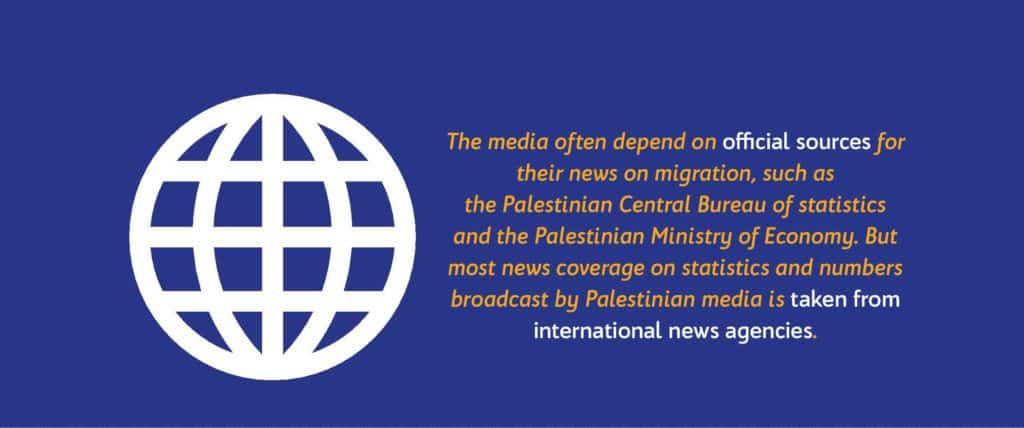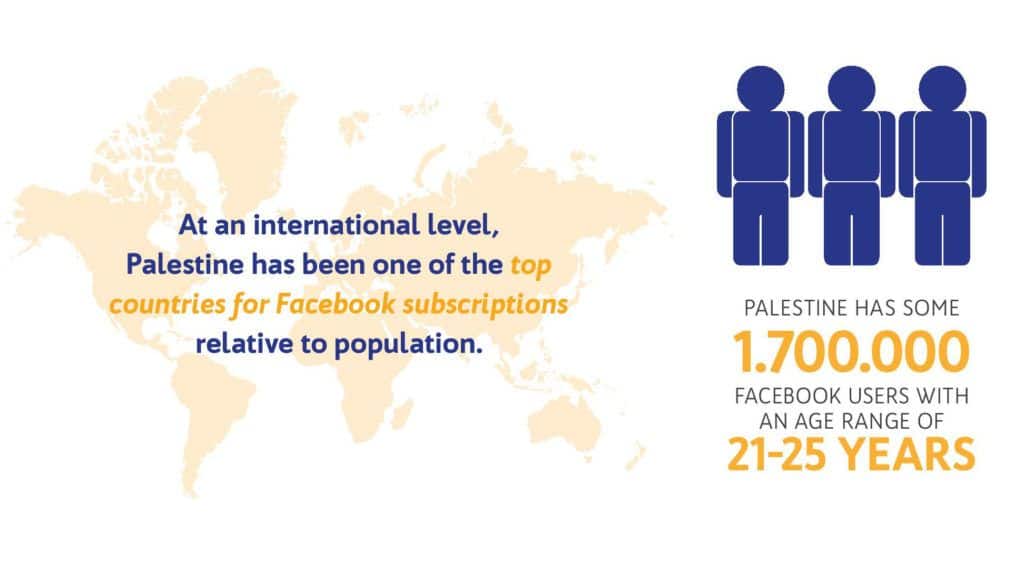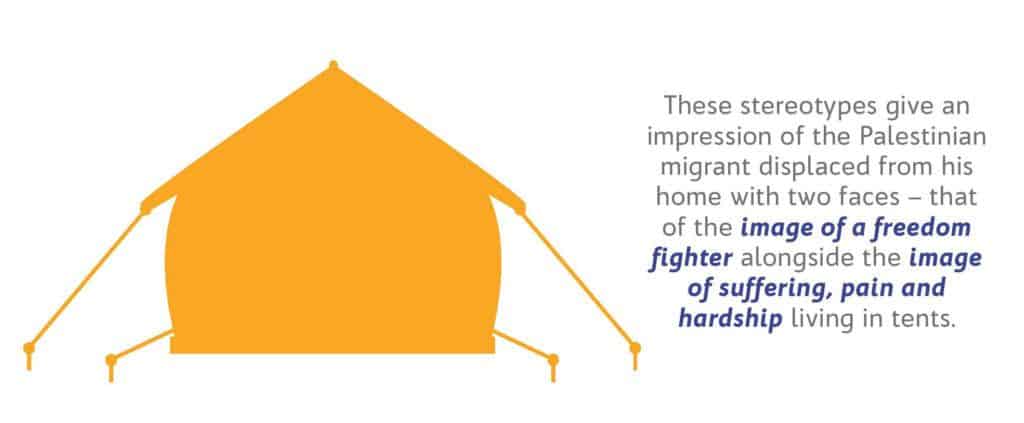This is a Chapter of the Study “How does the media on both sides of the Mediterranean report on migration?” carried out and prepared by the Ethical Journalism Network and commissioned in the framework of EUROMED Migration IV – a project, financed by the European Union and implemented by ICMPD. © European Union, 2017.
PALESTINE
Unforgettable History, Returning Money and Political Bias Shape the Migration News Agenda
Bassam Ewaida
The story of migration today figures strongly in Palestinian media but it’s almost always told in the context of Palestine’s own history of tragedy and refugee crisis. During 2015-2016 coverage focused on the thousands of Syrians fleeing the civil war particularly to Europe via the Mediterranean as well as the plight of people displaced by conflicts in Iraq and Yemen.
Their stories of migration and suffering have been linked through a clear line and common methodology among the official, private or party media to the continuing ordeal of Palestinians under Israeli occupation. The suffering of migrants and refugees is seen in the context of the events during the Palestinian Nakba (Catastrophe) in 1948 when tens of thousands of Palestinians were forced to leave their homes.
The term “migration” is common and well-understood in Palestinian media. Several newspapers like Alquds say that Palestinians are the best people on earth to understand its meaning since forced migration constitutes a humanitarian issue in Palestine for more than 60 years since people were forced out of their homeland as a result of killing and destruction.
Migration and refugee cases are broadly covered by all Palestinian media which regularly report on cases of young Palestinians threatened by the Israeli occupation who are forced to seek refuge in other countries, such as Turkey, leaving through the Gaza tunnels.
On 23 February 2015, for instance, Maan News Agency published a report that 40% of West Bank residents planned to leave Palestine for work and to live in political and economic stability. On the same day, Alquds Alarabi newspaper, published in London, stated that 30% of West Bank residents are considering leaving because they are unable to work. One of the key issues covered by media related to migration is the issue of expatriates’ money transfers and investments in the Palestinian land. Padico holding company is the Palestinian leader in diaspora investment in Ramallah on the West Bank. The company occupies much space on the economic pages of the daily Palestinian newspapers such as Alayam and Alquds.
This is part of the media focus on Palestinian migrants living outside Palestine. In Latin America, for instance, there are 700,000 of them, 350.000 of which live in Chile alone.
Palestinian newspapers have reported that the total money transfers to Palestine by expatriates in 2014 were worth about $1.84 billion. Most of these transfers came from the Arab Gulf states, the United States and from European Union countries. The issue is covered in detail by Palestinian Studies Journal (Majalat Adirasat Alfalastinia), which in issue No.59, produced a detailed report on how migrants invest in Palestine. These questions are followed in detail by Alhayah Aljadida daily, affiliated to the Palestinian Authority, and Maan news Agency, a private agency supported by the Netherlands and Denmark, which gives special importance to the expatriates’ investments in diaspora, particularly in Turkey.
It’s a subject that inspires official interest. Alhayah Aljadida newspaper reported that the Palestinian Trade Center (Paltrade) and the Palestinian Investment Promotion Agency held two workshops in Turkey in August 2015 to activate communication between Palestinian businessmen in the diaspora and trade supporting institutions in Turkey. The workshops were sponsored by the Palestinian-Turkish businessmen’s union and advised on investment in Palestine, Palestinian products, export capacity as well as the investment and export environment in Palestine.
Elsewhere, the evidence suggests there is plentiful and continual coverage of migration issues, although there are no official figures on the number of news reports, interviews and photos published since 2015 on migration. The Palestinian media uses two methods of covering migration issues, one focused on emotional and human interest aspects and the other on fact-based reporting. The Palestinian media like others used the photo of Aylan Kurdi, the Syrian toddler found dead on a Turkish beach, comparing it with the photo of Mohammad Durra, the Palestinian child killed by the Israeli forces during the Palestinian uprising (Intifada) in 2000. Sometimes there were comparisons between the tragedy of Syrian migrants from Aleppo or Iraqis from Mosul and the Palestinian people’s migration from Haifa and Jaffa in 1984.
Media use all kinds of visuals (infographics, graphics, video, charts and interactive maps) to show refugee numbers, ages and the countries they migrate to and then compare them with previous years. One of the most famous pictures used by the media was that of a foundering boat in the midst of stormy seas carrying hundreds of immigrant.
In another example, photos of refugees in a Greek camp published by Alhayah Aljadida newspaper showing women hanging their clothes to dry in an open ground were compared with archive photographs of Palestinian women hanging their clothes on electricity wires on the public road in Shatila refugee camp in Lebanon.2 Almost daily, one can find items, reports or photographs of refugees on the front page of the Palestinian newspaper Alayyam.
The peak media coverage was between January – July 2016 when more than one million Syrians migrated to Europe, particularly to Germany. But since then coverage of refugees has fallen.
The Palestinian media also report on different migrating groups inside the region occupied in 1967 and in surrounding countries (Jordan, Lebanon and Syria) and between the West Bank and Gaza. The media has followed the Palestinian migrant situation in Gaza, especially since the Israeli war in 2014, as well as the destruction of the Alyarmouk camp in Syria. There are many challenges facing the editorial rooms in the Palestinian media, not least gaining access to reliable data and statistics. The media often depends on official sources for their news on migration, such as the Palestinian Central Bureau of statistics and the Palestinian Ministry of Economy. But most news coverage on statistics and numbers broadcast by Palestinian media is taken from international news agencies.
The role played by political and economic interests in newsrooms is critical and many political parties and social movements exert a powerful influence. The messages from Palestinian satellite channels on the Syrian crisis are subject to influence. The Hamas move from Damascus to Qatar has left its impression on Alaqsa satellite channel coverage of Syria, which was in sharp contrast to Falastin Alyawm channel which affiliated to the Islamic Jihad movement.
While all Palestinian media organisations run stories on the endurance of displaced Syrians, Iraqis and Palestinians, explanations for their migration differ. Alaqsa channel, affiliated to Hamas, for instance, says the reason behind the migration of thousands of Palestinians from Al-Yarmouk camp in Syria is Basher Assad’s regime and the military ”assault” of the Syrian army against Palestinian civilians in the camp. On the other hand Falastin Alyawm says that the reason for migration from Al-yarmouk camp is action by extreme terrorist groups in Syria like ISIS, and others.
These views are reflected in the political terms and language used in the news bulletins with channels apportioning blame for the Al-yarmouk attacks in line with their political bias.
Palestine TV, affiliated to the Palestinian Authority, attempts to be neutral. It does not blame Assad’s regime for the migration of thousands of Palestinians in order to allow for direct communication with the regime. It seeks to maintain equal political distance between Qatar, Saudi Arabia and Turkey on the one hand, and the Syrian government and Russia on the other.
But different approaches persist. Alaqsa channel has no correspondent in Al-yarmouk camp, while Falastin Alyawm has a permanent correspondent in addition to an editor for Palestinian affairs. On 24 April 2015, Falastin Alyawm reported: “The Palestinian Akram Kusa martyred by sniper gunshot at the entrance of Al-yarmouk camp”. On the same day, Alaqsa broadcast: Palestinians martyred by sniper gunshot from the Syrian regime at the entrance of Al-yarmouk camp.
The former dropped from its news the notion of “Syrian regime” responsibility for the killing while Alaqsa uses political, not informative, terms when addressing Palestinians migration. It is noticeable how the media discourse of these two channels is similar to that of Hamas and Islamic jihad movements. Alaqsa policy reveals the nature of political relations with Qatar and the tense relationship with Iran and Hezbollah which led to the cutting off of Iranian aid to Hamas, which at one point was up to 280 million USD annually.


Another problem is hate speech in media even though it is banned in law. Article (7- clause “a”) of the Palestinian Press and Publication law prevents publishing anything that might stir up violence, intolerance, racism and sectarianism. Article (3 a) bans articles that harm national unity, incite hatred, or spread seeds of hostility, disagreement, and arouse sectarianism in the community. In addition, the Palestinian Journalists Syndicate Code calls for ”values of tolerance, acceptance of other opinions, denouncing defamation, discarding incitement to violence and hatred against any person, party or institution on the basis of sex , ethnicity, religion or political affiliation”.
Nevertheless, the Palestinian territories is a leader among Arab countries in respect of hate speech, especially after the 2006 split between the West Bank controlled by Fatah and Gaza controlled by Hamas. The Palestinian split is reflected in most aspects of life, including the division of war prisoners, martyrs and exposing the political arrests practiced by the Palestinian Authority.
On 26 February 2016, the programme Hadath Wa abaad (event & dimensions) aired on Falastin Alyawm was dedicated to political arrests. During the broadcast Nafith Azzam, the leader of the Islamic Jihad movement equated political arrests practiced by the Palestinian Authority and to those of Israel.
There are no codes of conduct or charters of honour that ban hate speech on Palestine TV and Wafa agency, both affiliated to the Palestinian Authority, nor is there for Alaqsa TV, or Falastin Alyawm TV. However, a women’s radio station called Nisa’ Fm bans incitement to violence and demands respect for pluralism and free expression.
The Palestinian media do give space for migrant voices to be heard. Palestine TV broadcast a special program called Arza wa zaitona (cedar and olive) from Lebanon, hosted by Maher Shalabi, which addressed the Palestinian refugee crisis in Lebanese refugee camps.
The Palestinian media has transmitted the voices and several topics about the Palestinian refugees from Syria, especially from Al-Yarmouk and Nayrab camps and from Iraq and Libya as well. Falastin Alyawm produced a programme on the Palestinian refugees suffering in Shatila camp. Al Quds press agency had a special interview with Muneer Maqdah, head of Fatah movement forces in Lebanon in which he said that some parties are seeking to eliminate Palestinian presence in Syria and that extreme organisations are not allowing supply aid into the camp. Also, the Palestinian Awdahcenter makes films on Palestinian refugees.
Few communities on social media have such a big impact on media coverage as that in Palestine. Palestine has some 1,700,000 Facebook users with an age range of 21-25 years old. This number is rapidly increasing. At international level, Palestine has been one of the top countries for Facebook subscriptions. But its popularity comes at a price. Because of social media problems, the Palestinian Public Attorney issued a decision on 3 January 2017 to crackdown on electronic crimes.
Social media do influence news coverage and sometimes they have a direct influence on political and social decisions. For instance, when Facebook activists launched a campaign to support Palestinian refugees in Alyarmouk, the Palestinian authority hastened to send aid to the refugees to calm down Palestinian public opinion. From time to time, the Palestinian Authority issues political or judicial decisions in response to social media pressure. Similarly, Palestinian media are often not to blame for stirring up the migration issue as a provocation; often the responsibility lies with social media activists.
Pictures of refugees in abject conditions transmitted by media, however, do rouse Palestinian public opinion. The stereotypical image of the current Palestinian refugees in Al-Yarmouk camp in Syria, or Iraq or Libya is particularly negative. It is often a dehumanised image of suffering, weakness, and agonised faces. It is the same stereotypical image of the Palestinian refugee in Gaza seen during the Israeli war of 2014: it is an image of refugees suffering from harsh realities — deprivation, poverty, and helplessness.
On the other hand, the image of Palestinian refugees in Europe or Latin America can be positive; it is a vision of the successful immigrant and investor who is well-mannered, strong, and smiling with a relaxed expression.
These stereotypes give an impression of the Palestinian migrant displaced from his home with two faces – that of the image of a freedom fighter alongside the image of suffering, pain and hardship living in tents.
This is seen in the way political bias operates in the editorial room. For example, in 2015, the Palestinian Authority’s Palestine TV featured photos of Palestinians whose homes were demolished by the Israeli occupation especially in Khuzaa district in the north of Gaza strip. They showed displaced people living in United Nations school accommodation. One family lives in one room and sometimes in school lavatories. Interviews are made with women crying because of their hard living conditions.
Conversely, Alaqsa channel avoids such reports in order not to highlight the state of despair among the residents and to maintain public morale. For this reason, Hamas, aware of media opposed to their political line, banned the distribution of Alquds, Alhayah Aljadida, Alayyam newspapers in Gaza for long periods and prevented Maan agency from covering the news in the area.
Palestinian journalists who cover migration are usually highly professional. They have long experience of reporting hot events in the occupied Palestinian territories and many have lost their lives to tell their stories.
The Palestinian media never rush to publish their migration related news, reports and news stories. They sometimes hasten to publish names of martyrs killed in the occupation and where they rely on Israeli sources or on Facebook.
But even so, Palestinian media are at a disadvantage. They often lack the financial resources to maintain specialist correspondents. None of the Palestinian newspapers (Alquds, Al Ayyam, Alhayah Aljadida),or the local radio stations (Raya, 24 ,Ajyal, Nisa FM, Najah) and Palestine TV, or news agencies, or Alaqsa TV have correspondents in Lebanon, Syria or Europe, or in Germany, where there are 800,000 Palestinians, or in Latin America. Only Falastin Alyawm has a correspondent in Syria who reports on news relating to the Palestinian refugees there.

Although advertising and commercial influence does affect media content there is no evidence of commercial pressure affecting the Palestinian media when it comes to the migration issue. The state of the relationship between the media and their audience differs from one medium to another. In local radios, there is wide cooperation as most of the local radios broadcast morning shows through which citizens can call but the level of interacting with audience in national such as Palestine TV is very low.
In conclusion, it is clear that the Palestinian media covers the migration story well, but they report it in a context which is uniquely Palestinian and reflects the history of suffering in the territories. However, the political interests of local parties, social movements and media owners have a decisive impact on the newsrooms of Palestinian media.
Although Palestinian journalists who cover migration issues are highly professional and there are outstanding examples of good reporting, the media coverage of migration tends to focus on emotional, human interest reporting or fact-based realities. Migration news is reported selectively in the party TV channels which often reflect a political bias which hinders media coverage. At the same time, social media have a great clear impact on the news and, as we have seen, can directly influence political decisions. The problem of negative stereotypes of Palestinian refugees remains a problem.
Recommendations
1. ORGANISING awareness-raising seminars and conferences that help people better understand the consequences of migration. Is Europe really the paradise described by social media? This is important given statistics that show 40% of West Bank residents are thinking of leaving.
2. PREPARING documentaries showing the hard realities facing Palestinians, Syrians and Iraqis in the target countries of migration (in Germany for example where there are around 800,000 Palestinians and one million Syrians).
3. DEVELOPING academic courses, for example, at Birzeit university in the West Bank on The Palestinian media and migration
4. CALLING upon Palestinian media to adopt self-regulation and codes of conduct banning hate speech and racism based on religion, race or sectarianism.
5. DEMANDING separation of editorial and administration in media institutions.
6. CALLING upon the Palestinian media to organise their own information sources on the migration issue and to appoint correspondents in refugee districts.
Bassam Ewaida is assistant professor at Birzeit University, Ramallah and Al-Quds University, Jerusalem. He is also a correspondent at the Arabic division of Funkhaus Europe.[/vc_column_text][vc_column_text]
References and links
1 http://www.pead.ps
2 “Alhayah Aljadida” newspaper 14 . 2 . 2015
3 http://www.pjs.ps/ar/pjs2/code-of-Conduct
4 https://www.youtube.com/watch?v=NrQyVdOJtLo
5 https://www.youtube.com/watch?v=bUxN6dHirP0